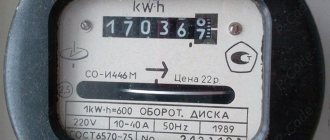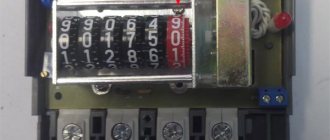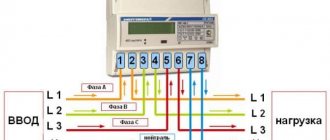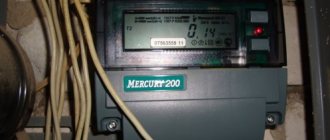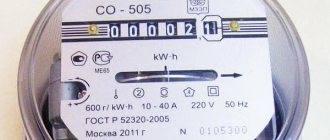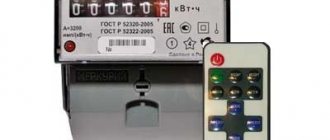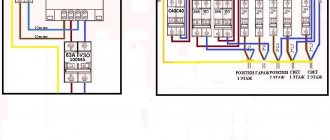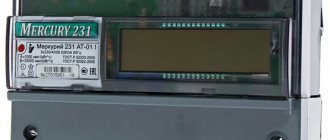Description of the counter
Types of electricity meters Mercury
The Mercury electricity meter was invented by Incotex. It produces various electronic equipment, but it is meters that are widely used.
Mercury is produced in a miniature case that fits into any room interior. Manufacturers have thought through all the details for attaching the device, so fixing it will not cause any difficulties. It is impossible to open the case, since there are no bolts in it, which has a positive effect on the safety of the device. Mercury is moisture resistant, so it can be installed even in basements.
There are models (for example, 201.22) that have a built-in PLC module. It additionally protects the meter and eliminates the possibility of electricity theft. There is also a Mercury electric meter with a remote control.
The service life is 30 years. These are some of the most durable meters used in homes. The manufacturer provides a 3-year warranty, which is enough to solve most emerging problems. Every 15 years the metering device must be checked; in some modifications the period is different.
The device has instructions for use, as well as a passport, which indicates all the properties. In addition, a diagram for connecting the device is attached, as well as a description of taking readings.
You should buy the product in a specialized store so as not to purchase a fake. Each meter is assigned its own identification code, which is then registered in the register.
Device service life
Mercury 202 is considered a highly reliable device. Factory life tests showed an average time between failures of at least 140,000 hours, while the service life of the Mercury 202 electric meter before overhaul is at least 30 years.
The warranty period, during which the manufacturer, subject to compliance with the installation and operation rules, undertakes to repair or replace a faulty device at its own expense, is 36 months, but not more than 42 months from the date of manufacture.
When purchasing a new meter, you must take into account that the guaranteed shelf life of the device is no more than 6 months from the date of manufacture. If the meter has not been installed during this time, the subsequent storage time is included in the warranty period.
The technical data sheet for the Mercury 200.5 meter can be downloaded HERE.
Types of metering devices
You can find various modifications of the Mercury electricity meter on sale. All of them can be used to account for electricity in the house. There are single-tariff, double-tariff, and three-tariff products.
Mercury 200
The Mercury two-tariff single-phase meter series 200 is used infrequently. Operates at a frequency of 50 Hz.
Mercury 201
This is one of the most popular types of metering devices for use in homes and businesses. There are single-phase, two-phase, single-tariff, multi-tariff. Thanks to their design, they are completely protected from hacking and attempts of unauthorized intervention in the operation of the device. They are also divided into several types and have their own distinctive features. Such devices include models 201.2; 201.5; 201.22. Designed for a rated current of 5 A and an operating current of up to 60 A. Models 201.4 and 201.6 have an increased maximum current of 80 A. They are used in places with a large amount of electricity. Electric meters of the 201 series display energy in different ways. 201.4 and 201.22 have a digital indicator, 201.5 and 201.6 have a mechanical indicator.
Mercury 230
The metering device is suitable for use in everyday life and in industrial environments. Often installed in cottages and private homes with a large number of electronics and household appliances.
A special modification designed for transformers is available for sale. It can perform its duties autonomously and in conjunction with an automated energy consumption metering system.
The Mercury 230 electric meter works similarly to other metering devices. Receives signals from sensors and translates information into a form understandable to the consumer - energy and power. It is possible to read data directly from the device or remotely.
Main design elements:
- frame;
- grounding device;
- contact block;
- lid.
The information in the meter is received and converted by a microprocessor.
Mercury 231
Three-phase single-tariff meter Mercury 231 is used for energy metering in networks with three phases. It can be connected directly or through a transformer.
The most famous modification is 231 AM-01. The device measures the load digitally. The kit includes fastenings for DIN rails and an anti-reverse counting device with a magnetic shield. The device has a simple mounting and does not cause any difficulties in operation. It is compact and lightweight.
Characteristics of Mercury 231:
- First class accuracy.
- Rated voltage 3*220/380 V.
- Rated current 5P.
- Maximum current 60 A.
- High sensitivity levels.
- The power consumed by the parallel circuit is no more than 0.1 W, the total power is no more than 7.5 W, the active power is no more than 1.5 W.
- Operating temperatures from -40°С to +55°С.
You can set a single tariff.
Mercury 234 ART
The Mercury 234 model is designed for one- and two-directional electricity metering in three-phase networks. The connection can be made through an instrument transformer and directly with the possibility of tariff metering by day zones. Information can be accumulated over a long period of time and can be transmitted through digital interfaces over wired or wireless channels.
Specifications:
- PLC-I interface.
- It is possible to connect additional power supply with a voltage of 230 V.
- Galvanically isolated pulse output.
- Automatic self-diagnosis of the device with error detection. The device can stop working on its own if a problem is detected.
- Availability of a built-in 60A relay.
- LCD backlight.
Main functions:
- Measurement, accounting, display, storage, transmission of information. Capable of performing all these actions with active and reactive energy, readings per day, week, month.
- Tariff accounting by zones.
- Accounting for losses in power lines.
- Measurement of auxiliary components - instantaneous power values, effective values of phase currents, network frequency.
- The event log.
The main use is in everyday life and in production.
Design and principle of operation
The body of the electric meter, consisting of a base, main and terminal covers, contains the following components:
- terminal strip with shunt;
- an electronic unit, including a power circuit, a removable battery, built-in memory, a pulse output, a control element;
- built-in modem for remote data transfer (for versions with LCD);
- liquid crystal display or mechanical calculating device (depending on modification).
The electrical energy passing through the device circuit is recorded by an electronic board, which, after processing the signal, displays data on the screen or reads it on a mechanical display. At the same time, the information is recorded by the telemetry system and transmitted to a modem connected to a remote monitoring device.
Connection diagrams
Single-phase and three-phase devices with a power limiter are installed in houses. The connection method depends on the number of phases.
The Mercury single-phase meter has 4 connections:
- Output to external network 220 V.
- Phase output from the meter to the apartment.
- Terminal for connecting zero from an external power supply to the device.
- Terminal from zero from the meter to the room.
The wires are connected in the same way.
Three-phase products have a more complex connection diagram, which depends on the type of meter. The most popular is direct connection without the use of transformers. It can be used at home, but manufacturing plants must install an AC-to-voltage converter.
How to check the meter yourself
There are several ways to check the counter:
- Check that the connection is correct. You need to make sure that the device is correctly connected to a 220 or 380 volt network. The connection diagram for single-phase meters looks like this:
If the connection does not match the example, you need to solve the problem as soon as possible. Incorrect connections not only lead to incorrect operation of the meter, but also to high fines.
Electrical diagram for meters with different numbers of phases
- You need to make sure that the disk does not rotate arbitrarily. To check this, you simply need to turn off all the circuit breakers behind the meter. To check in the absence of automatic equipment, you need to unplug all devices from the outlet, and then turn off all lighting fixtures. After 10-15 minutes, conduct a visual inspection to see if there are flashing lights on the front panel and if the counter is rotating. The counter is operational if the rotation stops.
- Calculate the measurement error. To check the correct operation of the meter, it is necessary to calculate the error of its measurement. To do this, you will need a regular incandescent lamp (as a load), a multimeter, a calculator and a stopwatch. As for the load, it is better to use a light bulb. The fact is that the power of modern household appliances can have different values when operating in different modes, so it is better not to use it as a load. You need to be guided by the capacity from the passport and use it in calculations, although in reality it will be a different value. Even if an error occurs at this stage, the home meter check does not work properly.
You might be interested in: Classes of circuit breakers
Accuracy check
- Checking magnetization. The models have an electromagnetic seal. The check is very simple - when the sticker is magnetized, special indicators change color.
The Mercury electric meter is a reliable measuring device that, in addition to power consumption, calculates many additional values. It also calculates prices at several rates, that is, it is multi-tariff. Connects to single-phase and three-phase networks. The good quality of its operation ensures energy savings.
Advantages and disadvantages
During the production of the product, developers are subject to the highest requirements for accuracy and reliability, as well as wide functionality and developed functions.
Main advantages:
- Wide selection of models.
- Quality and reliability.
- Low cost of the product.
- Protection against hacking and unauthorized access.
- Simplicity and ease of use.
- Use of modern components.
- Multifunctionality.
- Miniature size.
- The ability to divide energy consumption into zones, which allows you to save significant financial resources.
- Extended temperature range.
- High accuracy of determination of results and low energy consumption.
- Possibility of creating an automated control system.
- Possibility of manual and automatic readings.
Not the entire population is ready to switch to Mercury energy meters. This is due to the following factors:
- The low cost of electricity deters people from switching to new metering devices, since they will take a long time to pay for themselves.
- Dividing the tariff into daytime and nighttime may require citizens to change their daily routine. For example, it is more profitable to use powerful installations at night. Same with production.
- Some groups of the population may have problems collecting data from the meter.
Despite the shortcomings, the Mercury electricity meter is one of the most convenient and profitable devices.
Specifications
| Characteristics | Magnitude |
| Rated voltage (Unom), V | 230 |
| Set operating voltage range in relation to Unom | 0,9 — 1,1 |
| Extended operating range in relation to Unom | 0,8 — 1,15 |
| Limit operating range in relation to Unom | 0 — 1,15 |
| Basic current value (Ib), A | 5 or 10 |
| Maximum current value (Imax), A | 60 or 80 |
| Accuracy class | 1 or 2 (indicated on the scale) |
| Rated frequency value, Hz | 50 |
| Starting current (sensitivity), A, no more: | |
| for a meter with Ib=5 A for a meter with Ib=10 A | 20 or 10 40 or 20 |
| Constant (gear ratio) of meters, imp/kWh | 6400 or 5000 or 3200 |
| Liquid crystal indicator: | |
| number of displayed digits unit price of the least significant digit when displaying energy, kWh | 8 0,01 |
| Reading device: | |
| number of displayed digits unit price of the least significant digit when displaying energy, kWh | 6 0,01 |
| Number of tariffs | 1 |
| Total power consumed by the current circuit, V*A, no more | 0,1 |
| Active power consumed by the voltage circuit, W, no more than: | |
| for meters for meters with PLC modem | 2 3,5 |
| Total power consumed by the voltage circuit, V*A, no more than: | |
| for meters for meters with PLC modem | 10 25 |
| Overall dimensions of the meter, mm, no more: | |
| height width length | 105 or 91 105 or 77 64 or 66 |
| Meter weight, kg, no more | 0,34 |
| Established operating temperature range, °C * for versions 201.7, 201.8 | -40. +55 *-45. +75 |
| Average time to failure, hours. | 220000 |
| Standard service life, years | 30 |
| Calibration interval, years | 16 |
| Price, increased rub. | from 660 |
Taking readings from the electric meter
There are two types of devices - with mechanical wheels and with an electronic display. The second is a simpler way of taking readings. Mechanical products have numbers on wheels that are responsible for the date, hours, amount of electricity and other indicators.
Regardless of the model, the data is read the same way. The only difference is pressing the enter button. On multi-zone products, readings are displayed in the order T1, T2, etc. To receive information on an electronic meter, you need to wait for the numbers to appear and write down the data.
There is a second way to obtain data: press the enter button several times until the desired values appear. Then the numbers are written without the symbols after the dot.
Replacing the battery
The device's autonomous power supply is installed inside, under the main housing cover. Depending on the design of this structural part, it is removed after unscrewing two screws or releasing the latches.
The battery is designed to last at least the duration of the verification interval, so it must be changed during the verification process. The case cover is sealed, so the user will not be able to get to the battery on his own.
After removing the cover, the old battery is removed and a new one is inserted in its place, with a similar arrangement of positive and negative poles.
Calibration interval
Electricity metering devices are subject to periodic verification.
The manufacturer determines the procedure for preparing the device for verification, its implementation and presentation of the results. Initial verification is carried out by factory specialists with the appropriate mark in the technical passport.
The calibration interval of the meter is 16 years.
After repair, the meter is subject to unscheduled verification. All verifications are recorded in the technical passport.
